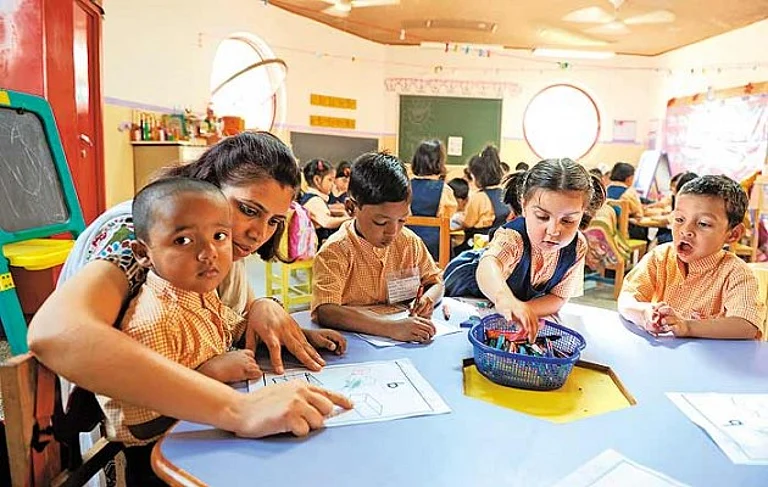All of us are currently focusing our resources and energies (and rightly so) to stay safe from the Corona virus pandemic. The ramifications of infectious diseases like these are visible in ashort time and scare people to take urgent action.
However, this is not the only health concern India needs to battle against. India’s nutrition or Poshan meter is also not showing signs of significant improvement. The difference between
communicable and diet-related non-communicable diseases is that the adverse impact of the latter is not immediate, and people often ignore them. With multiple forms of malnutrition (under- and over- nutrition coupled with rampant micronutrient deficiencies), decreasing physical activity, deteriorating climatic conditions, increasing morbidities and mortality due to poor diets, India is already experiencing and moving rapidly towards lower productivity and higher healthcare expenses. Only 6.4% of Indian children (less than 7 out of every 100 children) under the age of two get minimum acceptable diet in India, as revealed by the latest Comprehensive National Nutrition Survey (CNNS). Of the multiple abysmal statistics on nutrition in India, I use this 6.4% statistic a lot in my writings, perhaps because this number signifies a very serious, deep rooted issue around our feeding habits, wellbeing and productivity.
It is therefore extremely important to take stock of India’s public health and nutrition (PHN) status. At the recent Poshan Pakhwada, we suggested several symbiotically linked strategies which may help accelerate the pace of improving PHN in India. These include:
•P- Partnerships, collaborations and convergence
Nutrition’s main problem is non effective translation from theory to practice. How do we break this jinx? India has one of the best portfolio of programs and policies in public nutrition, but they fail when it comes to effective implementation. It’s time we realized that the answers lie outside the purview of nutrition science alone. The science has brought us where we are, and of course it will continue to evolve as science progresses. But now it is time to work in conjunction with our friends from other public health stream like economics, agriculture, environment, rural and urban development, education, anthropology, etc. Unless we converge our strengths to fight malnutrition holistically and multi-sectorally, we won’t reach far. Success will be determined by the support we garner, the steps we take jointly and identifying malnutrition as a common enemy.
•O- Orchestrate ‘Jan Andolan’ by empowering people
Nothing will work unless people change their behaviour. Context specific interventions to catalyze behavior change towards healthier practices must be identified and tested urgently. For this, we must: Revive local traditional cuisines with fresh seasonal locally available ingredients using social advocacy and media.
Rope in all stakeholders to repeat harmonized messages across sectors, nudging people to choose a healthy diet . Information on better health and nutrition must be accompanied by enabling policies like making healthier foods cheaper and available. We must try to promote healthy living at schools, workplaces, religious and public gatherings.
•S- Strengthen capacity, leadership and accountability
The Ministry of Women and Child Development has launched a Swasth Bharat Preraks (SBP) Program as an opportunity for India’s young leaders to contribute to nation-building by catalyzing effectiveand successful implementation of the NNM. These SBPs are being trained to be game changers for fast-track implementation of the NNM, and to promote better and integrated action around all 3 pillars of malnutrition: nutrition specific, nutrition sensitive, and enabling environment.
•H- Healthy sustainable diets for all
Identifying sustainable diets that promote health and minimize environmental impact is increasingly important. Latest research confirms that dietary water footprints (related to surface and ground water) in Asia are particularly high. Groundwater resources are depleting in many areas and climate change could further disrupt normal patterns of rainfall and irrigation water supply, fueling water scarcity. Improvements in nutritional status could be achieved through switching to more nutrient-dense and water-efficient crops. Development of appropriate environment– agriculture–nutrition linkages, with strong agricultural and nutrition extension work, can only be beneficial and must be tested. For example, cereals such as maize, millet, and sorghum could be promoted and used instead of merely focusing on rice and wheat in India. However, the economic growth and consequent urbanization in Asia has seen diets change to include more processed foods with more fatand refined carbohydrates, along with more milk and meat, with less cereals. The manufacture, advertising, sale and consumption of HFSS foods (high fat, sugar and salt foods) must be checked urgently. The economic aspect and social advocacy must also be kept in mind as most of the HFSS junk food are usually way cheaper and more attractive than healthy foods. One PHN strategy that hasbecome popular is to fortify staple foods with the deficient micronutrients. As a stopgap and temporary strategy, this may be okay, but eventually, structural changes are required in the way the production of food is diversified through incentivization as well as investment in research and development. There is no use fortifying sugary beverages, for example.
•A-Advance science and technology in nutrition research
India severely lacks capacity in high quality nutrition research. In fact poorly conducted studies often confuse more than they illuminate the path to right nutrition. One day saturated fats isbad, next day they are good; this is followed by we don’t know enough, more research is warranted or underway etc. All this is acceptable if this advances the field even slightly, but they should not send us around in circles. Improvements in methods is another area which needs a tremendous boost in nutrition space. Our commonly used dietary data collection tools are antiquated and prone to huge measurement errors. Biomarkers, nutrigenomics are also areas which need more research and must be made more accessible and affordable. Technology is and should further accelerate our ambition to attain better PHN for all. Secure sustained funding to science, stakeholder consultations for data use, preparation of high quality research proposals and publications – a lot is happening over the last few years, but they need to be substantially amplified. Investing in infrastructure is good, but optimal mentorship is equally critical. National capacity in PHN must be nurtured. Opportunities to engage with and learn from global leaders also should be within reach of all our academic and research institutions. Necessary collaborations, partnerships should be forged and facilitated by senior leadership at various levels.
•N-Nutrition across lifecourse
Leaders and experts in the PHN space are now pushing for integrated holistic approaches over piecemeal solutions/interventions to solve multiple forms of malnutrition. Specific focus on early-life nutrition from fetal to early childhood is necessary, as this has long-term physiological programming consequences on health, functioning, and chronic diseases. Therefore, the implementation of appropriate maternal and child nutrition policies and programs, focusing on preventing malnutrition in early life, should be a high priority. Maternal nutrition before and during pregnancy, postpartum/lactation with attention to optimal gestational weight gain, and the prevention/control of GDM in Asia need more attention. Improving the coverage, the timeliness and the quality of antenatal care is urgent in many Asian countries. Even while babies are born reasonably close to normal length and weight-for age, it is clear from inspections of global data that growth begins to falter early, even before exclusive breast feeding is replaced by complementary feeding. The promotion of optimal linear growth during the first two years therefore needs a combination of approaches to the household as well as community child care, with careful attention to the diet, education, and the environment. It is important to be mindful of the consequences of overfeeding by monitoring children for appropriate weight gain to prevent adiposity rebound in later childhood. Adolescent nutrition, especially for girls, and the delay of early pregnancy is also very important for halting the malnutrition cycle.
The gain accrued from each of the above strategies will positively influence and impact wellbeing of our people. India will see huge strides in productivity and good health of its masses once ourcommitment to PHN is holistic in nature, supportive in form of people-centric programs and policies and effective in terms of bringing about positive behavior change. All of us must therefore embrace Poshan Abhiyaan to help India become ‘Suposhit and Kuposhan Mukt Bharat’.
(Dr Shweta Khandelwal is head, Nutrition Research and Additional Professor at the Public Health Foundation of India)


























